The Faculty Areas of Research Seminar Series
The Faculty Areas of Research Seminar Series is designed to inform the Stanford mathematical community about the current research activities and interests of the mathematics department faculty. First- and second-year graduate students are particularly encouraged to attend these seminars in order to acquaint themselves further with the current research in the department and to assist in their selection of a dissertation advisor, but of course all are welcome.
| Time: |
Mondays, 12:15–1:05pm. |
| Location: |
383-N, Building 380. |
| Food? |
Will be provided. |
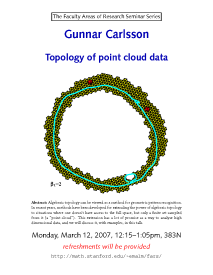
March 12, 2007: Gunnar Carlsson
"Topology of point cloud data"
Abstract: Algebraic topology can be viewed as a method for geometric pattern recognition. In recent years, methods have been developed for extending the power of algebraic topology to situations where one doesn't have access to the full space, but only a finite set sampled from it (a "point cloud"). This extension has a lot of promise as a way to analyze high dimensional data, and we will discuss it, with examples, in this talk.
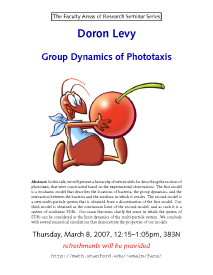
March 8, 2007: Doron Levy
"Group dynamics of phototaxis"
Abstract: Microbes live in fluctuating environments that are often limiting for growth. They have evolved several sophisticated mechanisms to sense changes in important environmental parameters such as light and nutrients. Most bacteria also have complex appendages that allow them to move, so they can swim or crawl into optimal conditions. This combination of sensing changes in the immediate environment and transducing these changes to the motion organisms, allows for movement in a particular direction: a phenomenon known as "chemotaxis" or "phototaxis".
Using time-lapse video microscopy we have monitored the movement of Cyanobacteria (which are phototaxis, i.e., bacteria that move towards light). These movies suggest that single cells are able to move directionally but at the same time, the group dynamics is equally important. The various patterns of movement that we observe appear to be a complex function of cell density, surface properties and genotype. Very little is known about the interactions between these parameters.
In this talk, we will present a hierarchy of new models for describing the motion of phototaxis, that were constructed based on the experimental observations. The first model is a stochastic model that describes the locations of bacteria, the group dynamics, and the interaction between the bacteria and the medium in which it resides. The second model is a new multi-particle system that is obtained from a discretization of the first model. Our third model is obtained as the continuum limit of the second model, and as such it is a system of nonlinear PDEs. Our main theorems clarify the sense in which the system of PDEs can be considered as the limit dynamics of the multi-particle system. We conclude with several numerical simulations that demonstrate the properties of our models. This is a joint work with Devaki Bhaya (Department of Plant Biology, Carnegie Institute) and Tiago Requeijo (Math, Stanford).
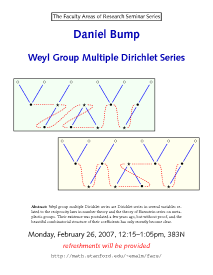
February 26, 2007: Daniel Bump
"Weyl group multiple Dirichlet series"
Abstract: Weyl group multiple Dirichlet series are Dirichlet series in several variables related to the reciprocity laws in number theory and the theory of Eisenstein series on metaplectic groups. Their existence was postulated a few years ago, but without proof, and the beautiful combinatorial structure of their coefficients has only recently become clear.
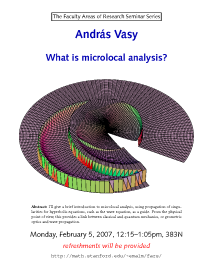
February 5, 2007: András Vasy
"What is microlocal analysis?"
Abstract: I'll give a brief introduction to microlocal analysis, using propagation of singularities for hyperbolic equations, such as the wave equation, as a guide. From the physical point of view, this provides a link between classical and quantum mechanics, or geometric optics and wave propagation.
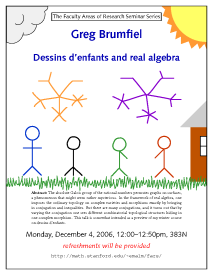
December 4, 2006: Greg Brumfiel
"Dessins d'enfants and real algebra"
Abstract: The absolute Galois group of the rational numbers permutes graphs on surfaces, a phenomenon that might seem rather mysterious. In the framework of real algebra, one imposes the ordinary topology on complex varieties and morphisms exactly by bringing in conjugation and inequalities. But there are many conjugations, and it turns out that by varying the conjugation one sees different combinatorial topological structures hiding in one complex morphism. This talk is somewhat intended as a preview of my winter course on dessins d'enfants.
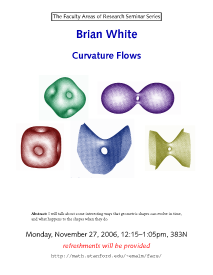
November 27, 2006: Brian White
"Curvature flows"
Abstract: I will talk about some interesting ways that geometric shapes can evolve in time, and what happens to the shapes when they do.
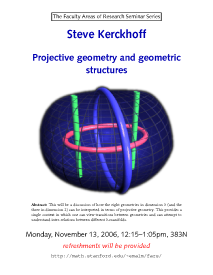
November 13, 2006: Steve Kerckhoff
"Projective geometry and geometric structures"
Abstract: This will be a discussion of how the eight geometries in dimension 3 (and the three in dimension 2) can be interpreted in terms of projective geometry. This provides a single context in which one can view transitions between geometries and can attempt to understand inter-relations between different 3-manifolds.
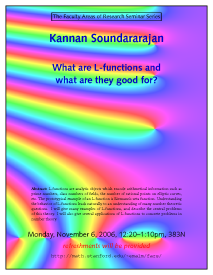
November 6, 2006: Kannan Soundararajan
"What are L-functions and what are they good for?"
Abstract: L-functions are analytic objects which encode arithmetical information such as prime numbers, class numbers of fields, the number of rational points on elliptic curves, etc. The prototypical example of an L-function is Riemann's zeta function. Understanding the behavior of L-functions leads naturally to an understanding of many number theoretic questions. I will give many examples of L-functions, and describe the central problems of this theory. I will also give several applications of L-functions to concrete problems in number theory.
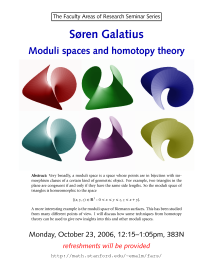
October 23, 2006: Søren Galatius
"Moduli spaces and homotopy theory"
Abstract: Very broadly, a moduli space is a space whose points are in bijection with isomorphism classes of a certain kind of geometric object. For example, two triangles in the plane are congruent if and only if they have the same side lengths. So the moduli space of triangles is homeomorphic to the space {(x, y, z) ∈ R³ : 0 < x ≤ y ≤ z, z < x + y}. A more interesting example is the moduli space of Riemann surfaces. This has been studied from many different points of view. I will discuss how some techniques from homotopy theory can be used to give new insights into this and other moduli spaces.
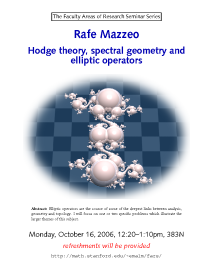
October 16, 2006: Rafe Mazzeo
"Hodge theory, spectral geometry and elliptic operators"
Abstract: Elliptic operators are the source of some of the deepest links between analysis, geometry and topology. I will focus on one or two specific problems which illustrate the larger themes of this subject.
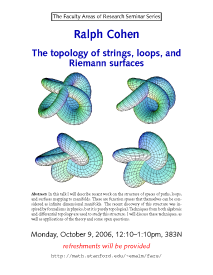
October 9, 2006: Ralph Cohen
"The topology of strings, loops, and Riemann surfaces"
Abstract: In this talk I will describe recent work on the structure of spaces of paths, loops, and surfaces mapping to manifolds. These are function spaces that themselves can be considered as infinite dimensional manifolds. The recent discovery of this structure was inspired by formalisms in physics, but it is purely topological. Techniques from both algebraic and differential topology are used to study this structure. I will discuss these techniques, as well as applications of the theory and some open questions.
Last modified: 03 Apr 2007











